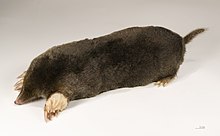Eulipotyphla
| Eulipotyphla Temporal range:
| |
|---|---|

| |
| Clockwise from upper left: a solenodon, hedgehog,[a] mole and shrew | |
| Scientific classification | |
| Domain: | Eukaryota |
| Kingdom: | Animalia |
| Phylum: | Chordata |
| Class: | Mammalia |
| Magnorder: | Boreoeutheria |
| Superorder: | Laurasiatheria |
| Order: | Eulipotyphla Waddell et al., 1999 |
| Families | |
| |
| Synonyms | |
| |
Eulipotyphla (polyphyletic order Lipotyphla, but not the afrotherian members (tenrecs, golden moles, and otter shrews, now in their own order Afrosoricida).
Eulipotyphla comprises the
A 2023 study suggested that the order began to diversify prior to the K-Pg extinction, based on molecular clock estimates.[5]
Classification


Soricidae
)Solenodontidae); solenodons are estimated to have diverged from other extant eulipotyphlans in the Late Cretaceous.[6][7]
- Order Eulipotyphla (= 'Lipotyphla' - Afrosoricida = 'Erinaceomorpha' + 'Soricomorpha')
- Family Erinaceidae[8]
- Subfamily Erinaceinae: hedgehogs
- Subfamily Galericinae: gymnures or moonrats
- Subfamily
- Family Soricidae[9]
- Subfamily Crocidurinae: white-toothed shrews
- Subfamily Soricinae: red-toothed shrews
- Subfamily Myosoricinae: African white-toothed shrews
- Subfamily
- Family Talpidae[10]
- Subfamily Talpinae: Old World moles and desmans
- Subfamily Scalopinae: New World moles
- Subfamily Uropsilinae: shrew-like moles
- Family Solenodontidae: solenodons
- † Family Nesophontidae: extinct West Indian shrews
- † Family Amphilemuridae
- † Family Nyctitheriidae
- † Family Plesiosoricidae
- Family Erinaceidae[8]
Family-level cladogram of modern eulipotyphlan relationships, following Roca et al. and Brace et al.:[3][11]
| Eulipotyphla |
| ||||||||||||||||||
The upper and lower
Ma) ago.[11][6][7] The Nesophontidae and Solenodontidae are thought to have separated roughly 57 Ma ago.[11] Split times for talpids vs. soricids plus erinaceids, and for soricids vs. erinaceids, have been estimated at 69 Ma and 64 Ma ago, respectively.[12]
Notes
- ^ Either a European hedgehog or a northern white-breasted hedgehog
References
- ^ Hassan, Mo (2009-10-11). "British Wildlife: N". The Disillusioned Taxonomist blog. Retrieved 2015-11-26.
- PMID 12383761.
- ^ S2CID 915633.
- S2CID 4314965.
- PMID 37104581.
- ^ a b de Lazaro, Enrico (19 March 2018). "Solenodon Genome Sequenced". Sci-News.com. Retrieved 2019-06-23.
- ^ PMID 29718205.
- PMID 28198504.
- S2CID 3136125.
- PMID 27795230.
- ^ PMID 27624716.
- PMID 29331683.
